Leann Tilley was born in Edenhope, in country Victoria. She attended Stawell
Primary School (St Patricks) and Marion College in Ararat for her secondary
education.
In her final year at school (Year 12) Leann studied English, General Mathematics, Biology, Chemistry and Physics.
Leann's degrees are BSc (Hons) from the University of Melbourne and PhD from the University of Sydney.
Since finishing her PhD Leann has worked at the following places:
Leann's interests include wine making, reading, movies and art.
The topic Dr Tilley chose to discuss was:
Interviewer: What is the main purpose of your research or the genetic
technique you use?
Dr Tilley: We are trying to understand the mechanisms by which
the malaria parasite ( Plasmodium falciparum ) disrupts the red
blood cells (erythrocytes) of the infected host. The malaria parasite lives
inside the red blood cells of its victim where it is safe from the host's
immune system. However, the parasite takes over the erythrocyte and puts
its own proteins into the red blood cell membrane to change the properties
of the erythrocyte. One of these proteins, called RESA, strengthens the
red cell membrane and helps the immature parasite to survive. Another called
the "knob" protein helps the sticking of erythrocytes infected
with mature parasitises to the walls of capillaries in the brain. This
eventually leads to the death of the person from 'cerebral malaria'. We
are using genetic technology to try to find out how the parasite gets these
proteins to the red cell membrane so that we can try to prevent this process.
Interviewer: Can you describe briefly how you are doing whatever
you do?
Dr Tilley:We first isolate the genes for the Plasmodium
knob protein and for RESA. Then we use modify the genes in ways which we
think will prevent the proteins from getting to the erythrocyte membrane.
Then we clone the normal genes and the modified genes into a plasmid.
We use the plasmid to transfer the genes, i.e. transfect
the genes into malaria-infected erythrocytes.
Once we have the genes inside the parasite, we follow the production of the proteins to see if they get to the erythrocyte's plasma membrane.
We hope that, once we have worked out exactly how this protein traficking occurs, we will be able to devise ways to stop it. If we can do that, we may have discovered a new, effective antimalarial treatment.
Interviewer: Who or what (animal or plant) will benefit from your
research/techniques?
Dr Tilley: The people who live in or travel through the world's
malaria areas will benefit if we are able to develop a new antimalarial
treatment.
Interviewer: What are the economic implications of your applied genetics?
(How expensive is it to do? What will be/are the cost benefits of the outcome?)
Dr Tilley: Malaria is prevalent in more than 90 countries in
the world, threatening 40 per cent of the world's popluation -- 2400 million
people. It is estimated that there are 300-500 million cases of malaria
a year and 1.5 - 2.7 million deaths. (World Health Organisation, 1996)
International expenditure on malaria research is about $84 million, or
$42 per death. This is not very much money when compared to research on other problems such as cancer or HIV/AIDS.
Our research is one of a number of Australian projects looking at malaria, and we have close links with the malaria researchers at the Walter and Eliza Hall Institute (WEHI) in Melbourne.
Interviewer: Historically, what is the scientific background to the
research you are now doing?
Dr Tilley: My early research interests were in looking at how
the malaria parasite altered the physical properties of the erythrocytes.
From there I became interested in studying the process whereby the parasite
gets proteins to sites outside its own cell, so that it can modify the
properties of the erythrocyte membrane. The recent development of methods
for transfection of malaria parasites by Dr. Alan Cowman has made the current
work possible (New Scientist, 1997).
Interviewer: For a Year 12 Biology student to understand what you
are doing, some background knowledge of biological concepts will be needed.
Can you tell me what biology is relevant to what you are doing, and why?
Dr Tilley: Many biological concepts are relevant to this
research.
Some understanding of the life cycle of the malaria parasite, Plasmodium, is necessary to understand why this is such a problem in certain countries of the world. The diagram below shows how RESA and the knob proteins are involved in the Plasmodium life cycle. (Interviewer: The students would have very likely studied this earlier in the year and could find more information about it in their VCE Biology text.)
Students need to have a knowledge of DNA structure and how, after transcription and translation of the triplet code of the bases in the gene, a protein product is formed. We use this biology in various ways:
Firstly, we need to clone the genes for the 'knob" protein and RESA. As we know the gene sequence, we can use PCR to amplify the gene in the laboratory. Students need to recognise that mutations within the gene can change the protein product of that gene. So what we are trying to do is to mutate the gene sequence to destroy the "signals" in the protein which are necessary for it to be transported to the erythrocyte membrane.
Once we have the genes that we want, we need to make sure that they can be made into proteins. We will make the proteins in bacteria in large amounts and use the purified proteins for making antibodies which will be useful for our studies.
We will then transfer the genes for RESA and the "knob" protein into malaria parasites (We can grow malaria parasites in the laboratory). The parasite will transcribe the genes and make proteins. We will use the antibodies that we have made to confirm that the parasite is producing the proteins and to determine the location of the proteins in the malaria-infected erythrocyte. We expect the normal versions of the proteins will be transported out to the erythrocyte membrane where they will assist in promoting parasite survival. We hope that the modified forms of the proteins will become "stuck" inside the parasite and may block the parasite's secretion system. This may impair the development of the parasite and make it more susceptible to killing by drugs or immune mechanisms.
Once we understand the processes that control the traffic of parasite proteins to the erythrocyte membrane, we will try to develop drugs which interfere with this process and "gum" up the parasites' transport systems. This could be a new means of killing the parasite. As the parasite is rapidly becoming resistant to chloroquine and other drugs which are used to treat it, it is very important that we get some new and more effective drugs.
Interviewer: I now need to know something of the techniques used
in your research. Can you tell me what techniques are important, and why
they are important?
Dr Tilley: A flow chart may make the work we do easier to understand:

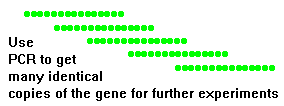

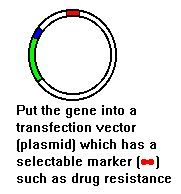
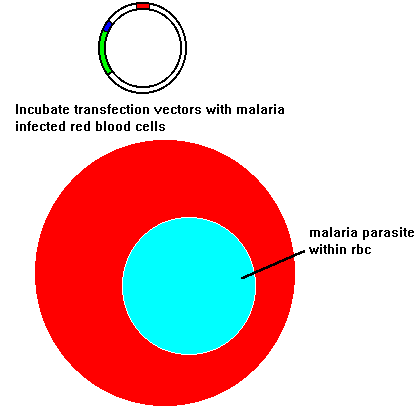
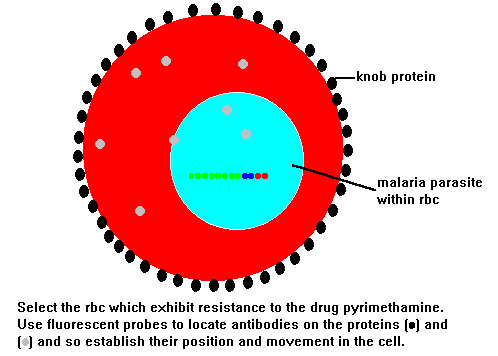
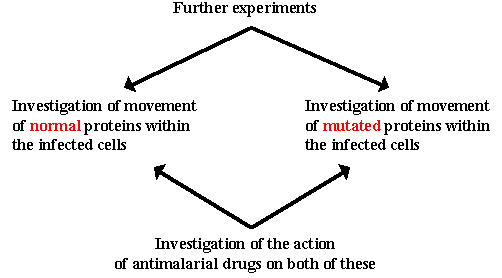
The main genetic techniques we use are:
Interviewer: What do you see as the major biological implications
of the work you are doing? For example; are genotypes or phenotypes being
altered?, is a species survival potential increased?, will someone or something
have a better quality of life?
Dr Tilley: As I said earlier, there are presently up to 3 million
deaths a year from malaria. If an effective, economical drug is developed
for the disease, many of those lives may be saved.
The consequences of that for the human populations in the malaria areas of the world are very important. These are many of the poorest countries of the world, but still the people there tend to have large families, putting a strain on already limited resources. Part of the reason that they have such large families is that at present up to 50% of the children die from malaria and other tropical diseases. With better disease control, people would have fewer children and the resources for community health could be distributed differently.
Interviewer: There is often discussion or debate about issues associated
with biotechnology. What is one such issue relating to your work? Can you
outline the arguments of the opposing sides of the debate please?
Dr Tilley: One of the main debates regarding treatment of people
with malaria concerns who is going to pay for it.
If new effective drugs are developed to treat malaria this will cost a great deal of money. The people who develop the drugs may well feel that they should be able to sell the drugs for a profit and so recoup the money spent in the drug's development. This is especially likely to be true if the developer is a large multinational drug company which is in business for the purpose of creating a profit for the shareholders.
On the other hand, the countries where malaria is a problem are generally very poor. Their citizens and their governments cannot afford expensive drugs. So what should happen to these people?
Some say that the World Health Organisation (WHO) has a role to play in all of this. Money for research and treatment of disease comes to the WHO from the wealthy Western governments. How the WHO uses this money is frequently a topic of discussion.
Interviewer: Can you suggest some reading material relevant to anything we have discussed about your work, its implications and issues associated with it?
Dr Tilley:Last year, the Herald-Sun science writer, Graeme O'Neil interviewed Dr Mick Foley and myself about our work. The report of the interview is on another page at this site, it's called "Malaria: solving a molecular jigsaw".
There is also a good book about malaria which I recommend to students here, it is:
Knell, A.J., Malaria Published by Oxford University Press, 1991
Any good bookshop would get it in for you, but I have found it available at DA Books, 648 Whitehorse Rd. Mitcham 3132. It costs under $20.
The Editorial in New Scientist (page 3) on 11 January 1997 was concerned with the role of WHO.
On the Internet there is information about research into malaria and other tropical diseases at "Malaria and Tropical Disease Weekly", and students could try searching for 'malaria' within the "multimedia reference library". Also, if you go to the 'search' page at the WHO www site and type 'malaria' you'll get lots of information about the disease and about WHO programmes that deal with it.
Other Internet sources of information are at the Malaria Foundation, and at the Australian Academy of Science NOVA Web site.
Interviewer: Thank you for your time.
References:
Young E. "Malaria's sticky killer surrenders" New Scientist
May 10, 1997, p21
World Health
Organisation, 1996. WHO facts. (WHO, www site), visited 13 May,
1997
You can read more about the work of Dr Tilley, and the people in her lab, by clicking here. You will see pictures of Dr Tilley, and her lab staff at the same location.
For ideas on where you might find additional resource material, look again at the section Resources on another page at this site. And don't forget the power of the Internet to provide you with information. A well thought out search, using a search engine such as Alta Vista, should provide more information than you can possibly use!
Please do not phone Dr Tilley for further information for your CAT. She, like the rest of the staff in Biochemistry, is a busy person. However, if you think we can help you some more, use either the comment form or the email address for this site and we will do what we can.
If you would like to read another interview with a La Trobe Biochemistry scientist, you can click here to go back to the Interview Index.If you would like to 'netsurf' for some more resources, you might find the author's favourite Biology Bookmarks helpful.
Click on Kick-the-cat to return to the VCE Biology Students' Home Page
![]()
![]()